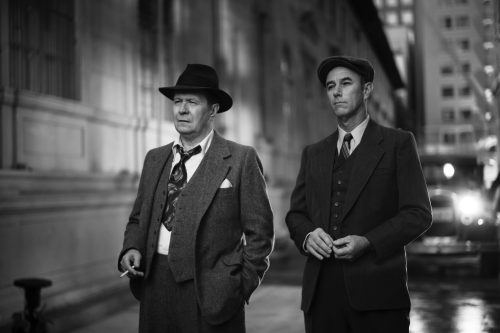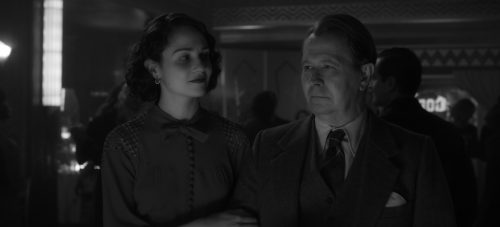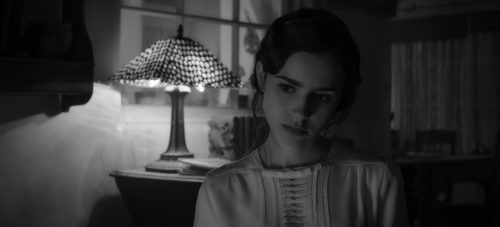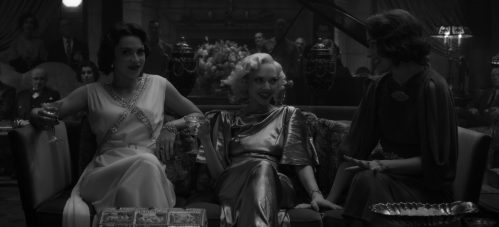 Back to selection
Back to selection
“Building the Character a Closet”: Costume Designer Trish Summerville on the 1930s Hollywood Style of David Fincher’s Mank
 Amanda Seyfried as Marion Davies in Mank (Photo: NETFLIX)
Amanda Seyfried as Marion Davies in Mank (Photo: NETFLIX) A repeat David Fincher collaborator after The Girl with the Dragon Tattoo (2011) and Gone Girl (2014), multi-award winning costume designer Trish Summerville has been signing her name onto numerous challenging film and TV projects throughout her storied, genre-spanning career, including the likes of The Hunger Games: Catching Fire and Red Sparrow. But Mank—Fincher’s meticulous creation of the Golden Age of Hollywood through the story of Herman J. Mankiewicz’s writing of Citizen Kane—and working in black-and-white presented a new challenge for the artisan, who had only done small projects in monochrome previously. “We were lucky; we were able to do a lot of camera tests prior to shooting,” explains Summerville. During the prep, her process included placing period-specific garments in various settings and taking black-and-white photographs of them on her phone, just to see how the colors would translate. “I was figuring out what’s going to be the closest to the lighting and the [shooting] style,” she recalls. “And then [focusing on] the details you see: what colors read well in black and white, what completely disappears, goes flat or absorbs too much light. I was looking for things that fit different scenes and have reflective qualities.”

Summerville went wide and varied for her detailed research of the era, reaching for magazines and looking at real-life photographs and cinematic references as much as possible. She kept a close eye towards representing every walk of Hollywood life, in order to project a complete and credible vision of the time. “As a costume designer, I don’t want to just have a fashion show,” Summerville says. “I’m into character development. I really enjoy working with actors, helping them get to that character, letting them have a new adventure in a new journey.”
Summerville recently spoke with Filmmaker, breaking down the intricate details of her work on Mank.
Filmmaker: Mank is not a nostalgic or exaggerated version of the Golden Age of Hollywood. It has a realistic point of view. And your costume work very much reflects that quality.
Summerville: It’s nice to hear you say that and that you saw that. David is a very authentic filmmaker. That’s the process we always take regardless of what the subject matter is. [While Mank] is a Hollywood film, a story about Citizen Kane, you’re looking at someone like Herman Mankiewicz. Even though he was a part of Hollywood like his brother [Joseph Mankiewicz], he was very much a real person, existed in a very particular economic lifestyle and setting. So we tried to show that. What made it creatively interesting for me was that we got to do these lush, glamorous party scenes — the Academy Awards, the Circus Party — but then also the everyday life of Mankiewicz and his progression through the years. His look stayed classic, but the alcoholism, the stress wore in him. Then you also see the workers on the backlot. It’s not just all the starlets and directors and L.B. Mayer, but [also] all the other people in the backlot that make the films happen. And we’re rolling out of this depression era. You have the people that are living on the dole and don’t have any money. So you see the wear and tear into their clothing. I think you really nailed it—we have every walk of life. It’s a very realistic film. It’s not over-the-top glam or out of character.
Filmmaker: Within regards to capturing the realities of The Great Depression, I recall a pair of scenes where Mankiewicz runs into an out-of-work actor, C.C. And you see the wear and tear you mentioned in his clothing. But then again, it’s put together and not a condescending view into his financial struggles. What goes into aging clothes appropriately that would register the right way?
Summerville: We see some of those gentlemen in the propaganda films as well. These were guys that at some point were actors or did background work. Once things started to go through this depression, they were out of work. So then they’re hired to make these propaganda films. They’re trying to make ends meet. So with them, we wanted to show that in that era (and up until probably the early ’60s), even if you didn’t have money, you tried to be extremely presentable. You were tucked in. They have dress shirts or button front shirts [and jackets]. But it’s probably the only clothing that they have. So I just made it really worn out through the collars. We did a lot of aging and breakdown on the shirts: the cuff in the shirt sleeves, around the pockets… Anywhere that you handle more or that your hands are going in and out. And all the hems on their pants were really aged down. We added some lived-in dirt on them. But they weren’t filthy. Because if you had some sort of access to water, you still tried to maintain [cleanliness]. Because these were the clothes you had, so you had to take care of them.

Filmmaker: About something you briefly touched upon earlier, the progression throughout the years is notable in Mank. We take a journey through the ’30s and you do notice the transitions; things that were carried over from the ’20s and heading into the ’40s.
Summerville: We had a lot of research going into it before we started fittings. And we pulled research from all over. For the Circus Party [for example], there were actual photographs of the various theme parties that were at the Hearst Mansion. We were able to find some real images of the Circus Party. We kind of rebuilt those costumes, changing them a bit but keeping them close to what was actually worn there.
For daily life, [we looked at] old Sears and Roebuck and J.C. Penney catalogs. And then also looking at Time magazines, Life magazines, and old films that depicted the ’30s and ’40s. Then doing photographic research—since we were dealing with a lot of characters that are real, you can find research information on them. And then what we tried to do was to take particular characters and look at what their lifestyle and clothing would be like. In the ’30s and ’40s (and again, probably up until the ’60s), fashion didn’t move as quickly as it does now. Now, we have disposable fast fashion. Whereas then, you bought very classic pieces because there weren’t so many options and people weren’t dressing in all these individual styles. There was a certain width of a lapel for certain years, or width of a tie, even the width in the fullness of trousers, especially for men. With Mank particularly (because we see him the most through this progression of time), [the idea was] keeping him very classic. And then just showing his weight gain through the years [via] his pants’ fit on his waist, having him be a little more disheveled growing into his alcoholism. [We had] stains on his clothes when he’s in the bungalow recuperating, like ashes and little bits of cigarette burns and sweat stains and stuff on his pajamas because he’s in bed.
And then you have someone like Thalberg, who was very fashionable and up to date in real life. He was married to a famous starlet and he traveled the world. So we changed his silhouettes throughout and gave him the fuller trousers. And then you have someone like Hearst. Even though he has quite a lot of money and is a knowledgeable, educated man, because of his age, his suiting stayed very traditional to earlier years. Very late ‘20s-early ‘30s. He’s one of the only characters we have that still wears a pocket watch. The other gentlemen have wristwatches on.
We tried to keep everybody very realistic to [their age], what their lifestyle was like, what their economic status was. We did the same thing with the women. Marion Davies [Amanda Seyfried] obviously is the one that is the most eye-catching in a room. Then you have Mank’s wife Sara [Tuppence Middleton], who was a beautiful woman, but her clothes were more conservative and understated.

Filmmaker: You really see that down-to-earth style in Lily Collins’ Rita Alexander too. I loved the costuming on her: grounded, with impeccably tailored with pencil skirts. Were her pieces all custom?
Summerville: We’ve built all the clothes for most of the principal cast, because if you’re looking at rentals and subletting clothing of that time, the garments are about 90 years old for actual pieces. So, the wear and tear is heavy. With Lily, the thing we really wanted to show was the progression of her relationship with Mank and this group of people that had become this family in the bungalow. You figure she’s brought every garment that she has with her because she thinks she’s there for 90 days minimum. We decided to make her a couple of skirt silhouettes, a few blouses; she has two suits. So [those are pieces] we can use as separates. We kept it very logical to how much money she had that she would actually spend on clothing. In the beginning, I chose to have her be much more buttoned up and presentable, because she’s meeting Mank for the first time. She wants to come in and be taken seriously. And as the relationship develops, it becomes more relaxed. She’s also in casual women’s blouses that are short-sleeved as we’re also dealing with summer heat. And then [we move] her into trousers. We kept her pieces simple, classic and delicate. Lily’s quite petite in her frame. So I didn’t want to give her anything that was too over-powering.
Filmmaker: She was a real woman of that era with a real wardrobe: limited but versatile pieces.
Summerville: It was important to do this thing we call in costuming, building the character a closet. You obviously go through the script. If there’s anything that’s mentioned particularly, an outdoor scene where you need a coat, or swimming [scene], you know you have to have these particular garments. But you also want to build them a closet of repeat pieces. So especially with Lily, and anyone going into this journey with Mank, we [thought of] these 90 days. I laid out, “what is she going to pack in this bag?” We talked to props: how many suitcases are we going to see them unload from the car? Lily would have a makeup case. She would have at least one suitcase. And it’s summer so we didn’t need coats, but we should probably have a sweater for cool evenings.

Filmmaker: And next to those everyday wardrobes, I of course love all the Hollywood glitz and glam too. To me, what Marion Davies [Amanda Seyfried] wears to L.B. Mayer’s birthday, the metallic gown, is a costume centerpiece of sorts. And it’s thoroughly showcased in the film: we see her sitting in it, then walking, then losing her balance by the fountain. So while it fits her like a glove, it’s also something she can obviously move in.
Summerville: That dress is kind of an antique gold color. It’s lamé with a slight crinkle through the fabric. For that particular party scene, I had been able to see what the room, the Hearst castle, was going to be like. I knew the seating and the light was a bit dark. And it was a lot of wood. We were going to have a lot of the principle cast there [as well as] background. I knew they were going to transition from being in that room, to her getting up, walking out and going out into the gardens and the zoo area. I knew Dave was going to light it [in the vein of] moonlight. So I really wanted her to be where your eye goes to in the room. It was kind of the same thing with the Circus Party. I needed your eye to go there. Because that’s who Mank’s attention [goes] to. He has a real fondness for Marion. And they kind of see things in very similar ways, compared to him being obsessed with Hearst or someone like that. That’s too easy and not who he really was. Because he’s watching what she’s doing in the room, I wanted the audience to [do the same], too.
Amanda is quite petite and fits really beautifully in period clothing. So I wanted it to be a bias cut gown. It was kind of clingy to her, very slinky. I also wanted it to have movement. That’s when I chose to do those sleeves that could move. And then I [gave] it a low back with Swarovski crystals across the back to also catch light. She looked great coming and going. I really like that Mank at some point ends up carrying her shoes because she’s carrying a bottle of gin. So I like that whole dynamic: she looks perfect in this room and starts having this dialogue about Hitler and the Nazis and how wrong and awful this is. She has this really strong political view of the world. She’s really aware of what’s going on, is super curious and wants to know more. But she’s in this really glamorous gown, has this perfect hair and makeup as the starlet. Then the conversation stops. So I wanted it to have that drama when she leaves. Mank stays in pretty dark tones. We did him in a lot of navy, gray and brown. So whenever he’s next to her, she always pops. It shows that he’s a man of the people and she loves him the way he is.
Filmmaker: And speaking of this gown, I just really love the vintage “Gowns by” credit in the beginning. “Gowns and costumes by Trish Summerville.”
Summerville: Yes, that was really nice. That was all David. I didn’t know about it. He sent me the poster and that’s where I saw it. So it was very nice.
Filmmaker: A nice throwback to “Gowns by Adrian” or Edith Head or Orry-Kelly. Were they inspirations in any way?
Summerville: I’ve always been a big fan of Adrian. Besides his gowns, which he’s quite famous for, his suiting was impeccable; the way all the pinstripes mitered up on every suit he made, whether it went from the color, or the lapel changing direction, or the pocket flaps, or the suit jacket going down into the skirt… Especially on women where you have darts and curves and hips. So I really appreciate that. What that inspires me [to do] is finding the fabrics. I can see the images of what I want in my head, and I have to find the fabric that I want. Or I stumble across something completely different and what I want changes, because I have found a fabric or trim or a button that really has moved me.
Filmmaker: Talking about Adrian’s suiting, I thought the suiting in this movie is impeccable, too.
Summerville: It’s a lot of suits!
Filmmaker: I mean, who knew filmmaking is a bit of a men’s club right?
Summerville: [Laughs affirmatively] Especially then.
Filmmaker: One menswear scene that is particularly memorable to me juxtaposes Mank, who is sort of this writer on the outside, against Irving Thalberg and L.B. Mayer. It’s the scene where he runs into them for the first time in the film k. They are sitting in these incredibly cool sunglasses and suits. Mayer is wearing a windowpane three-piece, and Thalberg is in a double breasted jacket. The scene makes such an unmistakable statement about who they were vs. who Mank is.
Summerville: Yes, that is another really fun scene for us because it’s the Hearst version of a home movie. I asked David, “Can I make it more of a garden party?” And he was like, “Show me what you mean.” So I showed him these very summery images of suits, linens, and people serving champagne outside, and croquet and stuff. And he’s like, “Yeah, we can do that.” A lot of the men’s suitings are traditionally dark colors, unless you’re doing a sporting event, or you are at a garden or theme party. So it gave me an opportunity to have some difference in season there and show an elitist kind of club that these men were all in. Thalberg’s [Ferdinand Kingsley] suit is a double breasted cream linen suit. Mayer’s [Arliss Howard] was a light-tan window-pane suit, with vest and bow tie. Arliss was so brilliant; he let me put him in plus fours, which are the pants that come just to the knee, and you wear high socks with it. They were both really great about it. I have some photos that I took of them on set together because they just looked really great.
The glasses added such a nice touch. Our props person, Trish Gallaher Glenn, really researched the period and had amazing props: beautiful glasses, signet rings, jewelry and watches for each section. When you pan over to them, they’re kind of laid back in these chairs with their sunglasses on, with all this attitude. And here comes Mank around the corner, who’s been in his suit for two days. Doesn’t know where he is, is completely disheveled and rumbled, but just cruises right on in and grabs an orange juice and walks right on over to Marion to have a conversation. He just fits into any scenario, even though he doesn’t look like he does.
Filmmaker: Do you keep tabs on how many unique outfits you design and make in a whole film?
Summerville: I don’t, because it could be overwhelming or change. I know that my supervisor and my assistants definitely know the numbers we need to meet. I just go along and design as I see it. I [once] did a TV series. At one point they kept changing the schedule and it was going to be either this battle scene with 150 guys in armor, or this village scene of 150 tribes people, 12 different tribes. So I had to be like, “Oh my God, we can’t do both. You have to pick one.” After that, I was like, “Okay, I can’t look at the numbers. I just have to tackle it.” You do it in an organized manner without stifling your creativity.
Filmmaker: Going back to menswear, we don’t get to see a lot of Orson Welles in the film. But in one particular scene, his larger-than-life aura comes forward in a black overcoat or cape and wide-brim hat. A magnificent dreamy vision with Tom Burke telegraphing Orson Welles’ grandness.
Summerville: When he directed and starred in Citizen Kane, Orson was only 25 years old. I think most of the general public sees Orson Welles as much older, as a really big stout kind of gentlemen. So for that [scene], we wanted it to be this iconic image of him, that cape and the black hat. When we think of Orson Welles, our minds kind of go there.
What I also like about that [scene] was, Mank is in this morphine trans. He’s just had this horrible accident. So I like the idea that you don’t know if it’s a hallucination or a drug-induced dream that Mank is actually having. Is it really Orson? The way it was shot was really beautiful, how they just have this shadowy image coming down the hall and the wind blowing. So you’re like, “Is he inside? Is he really there? Is it in Mank’s mind?” And then taking him from that to when we do actually see Orson when he was much younger: he wore shirts that have very elongated collars. We made his collars [about] three and a half inches; quite long, and really full trousers. He wore a fuller pant, which was what a lot of the younger, more fashionable men wore at the time. All of his shirts are monograms because he was a bit impeccable, extremely vain. We wanted that to translate whenever we did see him.
Filmmaker: I love how Tom Burke carries those costumes, too. I’ve seen him in The Souvenir, which is also a very costume-y film. He has an imposing way of wearing certain types of garments.
Summerville: He does. He has a very big presence. And I have to say it was really almost eerie and creepy, the tone of his voice, how much he did sound like Orson Welles. I think he did a beautiful job.
Filmmaker: You’ve collaborated with David Fincher before. Gone Girl, The Girl with the Dragon Tattoo and now Mank. I know that he is extremely detail-oriented but how involved or hands-on is he with your process as a costume designer?
Summerville: I’ve been very lucky to work with him on a few projects. We have a good shorthand now. I know how he works and what [he] will be particular [about]. Early on, I make a lot of boards for theme, vibe and overall world. And I do color tonal palettes. With this one, it was obviously different because we were in black and white. But it was just showing him where I would have pattern, where I wouldn’t, [also considering] the economical status of all the people in [different scenes of] the film. And then I do illustrations, show fabric swatches and then do the fittings. I just show him what’s in the fittings and where we think we’re placing stuff. And so a lot of times he’ll be like, “Oh, let’s put them like that. That set’s going to be quite dark. So maybe we need to go with something lighter there.” So it’s a lot of technical things.
He has a really good eye for fashion. One of the things that’s really reassuring is, he’s already seen the whole project, the whole film in his head, start to finish. Music laid-in, edited, all of it. So when you have these conversations with him, he knows exactly what it looks like. He’s very clear on what it is he wants. But he’s also very open and he’ll let you collaborate with him. He brings you all in and let you be creative. And one of the things I love is that he says, “Show me more. What else do you have? Let’s see more stuff.” He’s very excited about things. I think people have a bit of a misconception with him. He is very particular, but doesn’t micromanage in any way. His films are so precise and sweep you into these worlds because he focuses all his attention on that. And then brings in people he knows he can trust.
